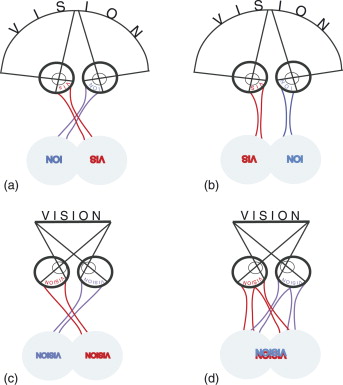Contents
- What is Eye Dominance?
- How to Determine Eye Dominance?
- Impact of Eye Dominance on Binocular Usage
- Eye Dominance: A Fascinating World
- Unraveling the Brain’s Marvelous Dance
- The Dual Nature of Dominance
- Binocular Vision: Merging Realities
- When Dominance Meets Compatibility:
- Vision Disorders and Eye Dominance:
- Frequently Asked Questions (FAQ’s)
- Conclusion
Our eyes are the windows to the world, granting us access to a rich tapestry of colors, shapes, and dimensions. But did you know that each of us has a dominant eye, one that our brain prefers over the other when processing visual information?
Eye dominance, also known as ocular dominance, is the tendency to prefer visual input from one eye over the other. It is important to understand eye dominance when using binoculars because it affects the quality of the image you see.
In this article, we will discuss eye dominance, how to determine which eye is dominant, and its impact on binocular usage.
What is Eye Dominance?
Eye dominance is the tendency to prefer visual input from one eye over the other. It is somewhat analogous to the laterality of right- or left-handedness, but the side of the dominant eye and the dominant hand do not always match.
This is because both hemispheres control both eyes, but each one takes charge of a different half of the field of vision, and therefore a different half of both retinas.
How to Determine Eye Dominance?
There are several ways to determine eye dominance.
- One way is to use the Porta test. Extend one arm in front of you and, with both eyes open, align your thumb or index finger with a distant object. Alternate closing each eye, and the eye that remains aligned with the object is your dominant eye.
- Another way is to use the Miles test. Extend your arms in front of you and create a triangular opening between your thumbs and pointer fingers by placing them together. With both of your eyes open, center this triangle on a distant object, like a clock or picture frame. Close your left eye. If the object stays centered, then your right eye is your dominant eye. If the object moves, then your left eye is your dominant eye.
Impact of Eye Dominance on Binocular Usage
Eye dominance can impact the quality of the image you see through binoculars. Your dominant eye may see a dark halo around the image if the ocular lenses of the binoculars don’t line up perfectly, resulting in an unsatisfactory view. It is important to adjust the binoculars to your dominant eye to avoid these issues.

Eye Dominance: A Fascinating World
Eye dominance, a captivating aspect of human vision, refers to the predisposition of the brain to rely more heavily on input from one eye than the other.
While both eyes work in harmony to form a coherent picture of the world, the dominant eye takes center stage, playing a vital role in how we perceive depth, distance, and spatial relationships.
Unraveling the Brain’s Marvelous Dance
At the core of eye dominance lies the intricate dance of the brain’s visual cortex, where visual information from each eye converges. Discovering how the brain’s hemispheres come into play, and the development of eye dominance in infants and young children, provides us with profound insights into our visual sense.
The Dual Nature of Dominance
Understanding the advantages and disadvantages of having a dominant eye is crucial in comprehending the nuances of binocular vision. Enhanced visual acuity and hand-eye coordination come hand in hand with potential challenges in tasks that require input from both eyes.
Binocular Vision: Merging Realities
Binocular vision is the symphony where our dominant eye collaborates with its counterpart to create a vivid 3D experience.
The fusion of images and the marvel of stereopsis lie at the heart of this wondrous process, enabling us to judge distances, catch fast-moving objects, and immerse ourselves in the world around us.
When Dominance Meets Compatibility:
The compatibility of our dominant eye with binocular vision is essential for seamless visual function. Yet, sometimes, our visual system faces conflicts that challenge our perception.

Vision Disorders and Eye Dominance:
Eye dominance can also intersect with vision disorders, such as amblyopia (lazy eye) and strabismus (crossed eyes). Understanding these connections allows for tailored treatments that take into account the dominant eye’s role in the healing process.
Frequently Asked Questions (FAQ’s)
Here are some frequently asked questions (FAQs) and answers about using an air fryer for the first time:
What is eye dominance, and why is it important?
Eye dominance is the tendency of the brain to prefer visual input from one eye over the other when both eyes are open. It is essential because it significantly influences how we perceive depth, distance, and spatial relationships. Understanding eye dominance can help optimize performance in various activities, such as sports and tasks that require precise hand-eye coordination.
How is eye dominance determined?
Eye dominance can be determined through various tests. Two common methods are the Miles test and the Porta test. In the Miles test, an individual extends their arms and forms a small triangle with their thumbs and index fingers, focusing on a distant object.
The dominant eye is the one through which the object remains visible when bringing the triangle closer. The Porta test involves framing an object with both hands and bringing it towards the face while keeping both eyes open. The dominant eye is the one through which the object remains centered and unchanged.
Can eye dominance change over time?
Eye dominance is typically established early in life, usually by the age of six. Once established, eye dominance is unlikely to change. However, in some cases, eye dominance may be affected by certain vision disorders or injuries.
How does eye dominance impact sports performance?
Eye dominance can have a significant impact on sports performance. For example, in sports like golf, archery, and shooting, knowing one’s dominant eye is crucial for aiming accuracy. In team sports, such as basketball or soccer, understanding eye dominance can help players assess distances and make more precise passes.
Is eye dominance related to driving safety?
Yes, eye dominance can affect driving safety. The dominant eye plays a crucial role in perceiving distance and assessing the speed and movement of surrounding vehicles. Being aware of one’s dominant eye can aid in mitigating potential visual challenges while on the road.
Can conflicts between eye dominance and binocular vision cause visual problems?
Yes, conflicts between eye dominance and binocular vision can lead to visual challenges or discomfort. When eye dominance conflicts with binocular vision, it may affect activities that require precise depth perception or the integration of information from both eyes, such as catching a ball or judging distances accurately.
How can conflicts between eye dominance and binocular vision be managed?
Strategies to improve the compatibility between eye dominance and binocular vision include vision therapy and specialized exercises. Vision therapy helps train the brain to more effectively use information from both eyes, enhancing overall visual function.
Can eye dominance be a factor in the development of certain vision disorders?
Yes, eye dominance can be a factor in the development of vision disorders such as amblyopia (lazy eye) and strabismus (crossed eyes). Amblyopia often leads to the dominance of the stronger eye, while strabismus can also influence eye dominance.
What does the future hold for understanding eye dominance?
Advancements in technology and research offer promising possibilities for a deeper understanding of eye dominance and its impact on binocular usage. Personalized vision therapies, innovative wearables, and advancements in virtual and augmented reality experiences hold the potential to reshape how we correct and optimize our visual challenges related to eye dominance.
Is there any way to improve binocular vision with a dominant eye?
Yes, there are strategies and exercises that can help improve binocular vision with a dominant eye. Vision therapy and eye exercises designed to promote binocular integration can be beneficial for enhancing overall visual function and reducing conflicts between eye dominance and binocular vision.
Conclusion
Understanding eye dominance and its impact on binocular usage is crucial for getting the best viewing experience. It is important to determine which eye is dominant and adjust the binoculars accordingly to avoid issues with the quality of the image you see.
When buying binoculars, it is recommended to check if the binoculars have an IPD adjustment mechanism and if they cater for differences in eye dominance. This will help you get the best viewing experience possible.

A Binoculars enthusiast, who love exploring skies and watching birds. It is my hobby to collect Binoculars of different kinds and try to explore the world through various lenses. This is all I do to explore happiness by magnifying my beautiful world.




